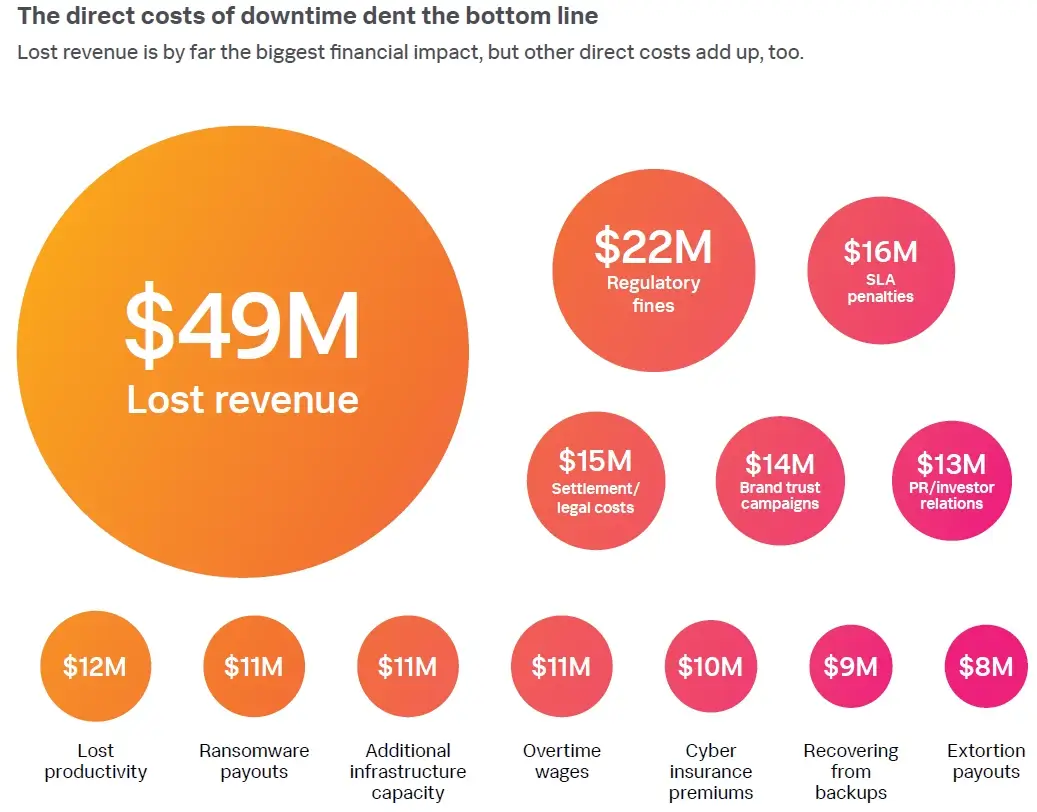
Uptime monitoring checks whether or not a web site, server, or on-line service is obtainable. It runs automated assessments at set intervals, verifying responses and sending alerts if a failure happens. Companies depend on uptime monitoring to detect points early, stop income loss, and keep buyer belief. An internet site outage can hurt fame, impression search engine optimization rankings, and disrupt operations.
Any enterprise with an internet presence advantages from uptime monitoring. E-commerce shops lose gross sales when websites crash, SaaS corporations should guarantee dependable service and monetary platforms require uninterrupted transactions. Healthcare, media, and different industries additionally rely upon steady availability. By monitoring uptime and alerting groups to points, monitoring helps companies repair issues earlier than customers are affected.
Desk of Contents:
Understanding Uptime Monitoring
How Uptime Monitoring Works
Why Uptime Monitoring Is Important
Uptime Monitoring vs. Availability Monitoring
Uptime Requirements for Compliance
Conclusion
Understanding Uptime Monitoring

What Is Uptime in IT & Internet Internet hosting?
Uptime is the share of time a system stays operational inside a particular interval. In IT and website hosting, it measures how lengthy a server, web site, or utility features with out failure. Excessive uptime ensures customers can entry providers with out interruption. Internet hosting suppliers and companies intention for optimum uptime to stop disruptions and keep efficiency.
Distinction Between Uptime & Web site Availability
Uptime tracks whether or not a system is working, whereas availability measures if customers can entry it with out points. A server could be on-line, however customers should still face outages if community congestion, server overload, or DNS failures happen. Availability considers precise consumer expertise, whereas uptime is a technical measure of system standing. Each are necessary for service reliability.
How Uptime Share Is Calculated (99.9%, 99.99%, 100%)
Uptime proportion is calculated as:
Uptime Share =
For a complete 12 months:
- 99.9% uptime permits as much as 8.76 hours of downtime.
- 99.99% uptime limits downtime to 52.56 minutes.
- 99.999% uptime (5 nines) restricts downtime to 5.26 minutes.
- 100% uptime means zero downtime, however it’s almost not possible resulting from upkeep and unexpected failures.
Significance of Uptime Monitoring for Enterprise Continuity
Companies rely upon uptime monitoring to stop losses attributable to downtime. An e-commerce web site experiencing outages can lose gross sales and clients. SaaS suppliers danger consumer churn if providers develop into unreliable. Serps decrease rankings for ceaselessly unavailable web sites. Uptime monitoring permits corporations to detect, diagnose, and resolve points earlier than they impression customers, guaranteeing secure efficiency and defending income.
How Uptime Monitoring Works

Kinds of Uptime Monitoring Strategies
Ping Monitoring (Checking Server Response Time)
Ping monitoring sends a small information packet to a server and measures the time it takes to reply. If the server doesn’t reply inside a set timeframe, it could be down or experiencing excessive latency.
HTTP(S) Monitoring (Web site Request & Standing Codes)
HTTP(S) monitoring checks if a web site responds accurately by sending HTTP requests. It verifies standing codes like 200 (OK) for regular operation or 500 (Server Error) for points. This methodology ensures net pages are accessible.
TCP Port Monitoring (Checking Particular Service Ports)
TCP port monitoring verifies whether or not important providers, equivalent to e mail (SMTP, IMAP) or databases (MySQL, PostgreSQL), can be found. It connects to particular ports to substantiate they settle for requests.
DNS Monitoring (Monitoring Area Decision Points)
DNS monitoring ensures domains resolve to the right IP addresses. It detects DNS misconfigurations, gradual decision occasions, or outages that may make a web site inaccessible.
Artificial Monitoring (Simulating Person Interactions)
Artificial monitoring runs simulated consumer actions, equivalent to logging in, including objects to a cart, or submitting kinds. This methodology identifies issues in advanced workflows that primary uptime checks would possibly miss.
Actual-Time Monitoring vs. Scheduled Monitoring
Actual-time monitoring checks system standing repeatedly and detects failures immediately. It supplies quick alerts when a web site or service turns into unavailable.
Scheduled monitoring runs assessments at predefined intervals, equivalent to each 1, 5, or 10 minutes. This methodology reduces server load however could delay difficulty detection in comparison with real-time monitoring.
How Monitoring Alerts Work
When an outage happens, uptime monitoring instruments ship alerts through different channels:
- E-mail Alerts – Notify IT groups about points with server logs for troubleshooting.
- SMS Alerts – Present quick notifications for pressing issues.
- Voice Calls – The voice name contacts will obtain an alert by a cellphone name
- On the spot messenger – On the spot messenger contacts could obtain alerts within the type of an prompt message utilizing their favourite messaging software program.
- Pager – The Numeric Pagers obtain alerts in numeric codes, every representing a particular error.
- SNMP entice – An SNMP entice is distributed to the configured server.
- URL notifications – The URL contacts will open a particular web page in case of an alert occasion.
- Slack & Different Integrations – Ship real-time alerts to staff collaboration instruments for quicker response.
Monitoring alerts assist companies react rapidly, minimizing downtime and stopping service disruptions.
Why Uptime Monitoring Is Essential

Income Loss Resulting from Downtime
Each minute a web site is down may end up in misplaced gross sales, particularly for e-commerce, SaaS, and monetary providers. If an internet retailer generates $10,000 per hour, a half-hour outage can result in a direct income lack of $5,000. For prime-traffic companies, losses could be a lot larger.
search engine optimization and Advertising Affect of Downtime
Serps penalize web sites with frequent downtime. Googlebot could fail to crawl an unavailable web site, inflicting rating drops. If downtime is extended, Google could take away pages from search outcomes, decreasing natural visitors.
Advertising campaigns drive web site visitors by means of paid advertisements, social media, and e mail promotions. If a web site goes down throughout a marketing campaign, guests see error messages as a substitute of touchdown pages, resulting in wasted advert spend and misplaced conversions.
Person Expertise & Buyer Belief Points
Customers anticipate web sites to work with out interruptions. Frequent downtime frustrates clients, rising bounce charges and reducing conversions. If a enterprise turns into unreliable, customers could swap to rivals.
Hidden Prices of Downtime
Downtime impacts greater than direct income loss. Worker productiveness drops as IT groups deal with troubleshooting as a substitute of standard duties. Gross sales groups miss alternatives, and buyer assist will get overwhelmed with complaints.
After an outage, customer support groups face a surge in inquiries from pissed off customers, rising workload and operational prices.
Repute injury spreads rapidly on social media and evaluate websites, decreasing buyer belief and long-term model worth. Uptime monitoring minimizes these dangers by guaranteeing quick difficulty detection and response.

Uptime Monitoring vs. Availability Monitoring
Uptime monitoring tracks whether or not a web site or server is on-line and responding. It measures response occasions and checks system standing utilizing ping assessments and HTTP requests. Nevertheless, a web site could be technically “up” however nonetheless unusable resulting from gradual loading occasions, damaged options, or partial outages. Availability monitoring goes additional by measuring whether or not customers can entry and work together with a web site or service as anticipated.
How Availability Monitoring Enhances Uptime Monitoring
Uptime monitoring ensures a web site or server is working, however availability monitoring checks your entire consumer expertise. A service is perhaps up however too gradual to make use of successfully, resulting in poor buyer satisfaction. Availability monitoring makes use of artificial assessments and real-user monitoring to detect these points, serving to companies optimize each efficiency and reliability. Utilizing each uptime and availability monitoring supplies an entire view of system well being.
Comparability Desk
| Issue | Uptime Monitoring | Availability Monitoring |
| Objective | Detects whether or not a server or web site is working | Checks if customers can entry providers correctly |
| Strategy | Measures response time & server standing | Measures consumer expertise & service reliability |
| Instruments Used | Ping assessments, HTTP checks | Artificial monitoring, real-user monitoring |
Each monitoring varieties are important. Uptime monitoring prevents full failures, whereas availability monitoring ensures customers can totally entry providers.
Uptime Necessities for Compliance

Sure industries require strict uptime requirements to satisfy authorized and contractual obligations. Rules like HIPAA, GDPR, and SLAs define uptime expectations to guard customers, guarantee information safety, and keep service reliability. Companies should monitor uptime to adjust to these requirements and keep away from penalties.
HIPAA & Uptime Monitoring for Healthcare
Healthcare providers should guarantee steady entry to affected person information and significant purposes. The Health Insurance Portability and Accountability Act (HIPAA) requires healthcare suppliers and IT distributors to keep up system availability, particularly for digital well being information (EHRs) and telemedicine platforms. Uptime monitoring helps detect and resolve downtime that would disrupt affected person care.
GDPR Issues for Web site Monitoring
The General Data Protection Regulation (GDPR) requires companies dealing with EU consumer information to guard data and guarantee service availability. If a web site goes down, customers could lose entry to information, resulting in compliance dangers. Uptime monitoring helps companies meet GDPR’s information accessibility and safety necessities.
SLA (Service Stage Settlement) Uptime Ensures
A Service Level Agreement (SLA) defines the uptime proportion a supplier ensures to clients. Widespread uptime commitments embrace 99.9% and 99.99%. If uptime drops beneath the agreed stage, companies could owe clients refunds or credit. Uptime monitoring ensures SLA compliance and helps suppliers meet contractual obligations.
Sustaining excessive uptime is crucial for regulatory compliance, buyer belief, and enterprise continuity. Monitoring instruments assist organizations detect, stop, and reply to downtime to satisfy authorized and contractual requirements.
Conclusion
Uptime monitoring detects outages, prevents income loss, and ensures service reliability. Companies depend on it to trace uptime percentages, meet compliance requirements, and keep buyer belief. Downtime impacts gross sales, search engine optimization rankings, and model fame, making monitoring important for industries like e-commerce, SaaS, finance, and healthcare.
Utilizing an uptime monitoring service, companies can arrange real-time monitoring, alerts, and detailed studies to reduce disruptions. Configuring correct notifications and analyzing studies helps stop recurring points.







